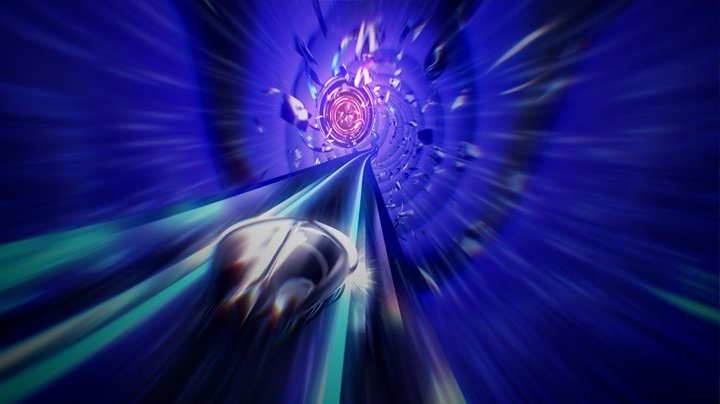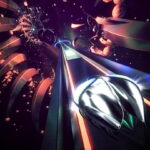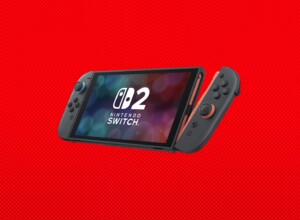At GDC this week, Marc Flury, co-founder of Drool, revealed how the two man studio created one of the indie highlights of 2016, the self-proclaimed ‘rhythm violence’ game, Thumper.
Development of Thumper began in 2009, with Flury – and fellow Drool co-founder Brian Gibson – originally aiming for release on the Xbox 360. Although both had previously worked in game development, Gibson had never art directed a full game before, and Flury – who predominantly coded game menus and UI – had limited knowledge of 3D mathematics and graphics.
“Brian is a very talented musician but he had never composed electronic music before,” says Flury. “And like a lot of people I was kind of pigeon-holed in my job, I did a lot of the same thing which also let me do some side jobs to make extra money.”
With Thumper they wanted to satisfy their artistic ambitions by creating a game – and its engine – from the ground up.
“Back in 2009 we set some initial goals. Number one was make an engine, and this was largely a personal goal of mine,” says Flury. “I had come to GDC, I had been to the Experimental Gameplay Workshop, I’d seen what designer/programmer hybrid types could do, and I was really impressed by that. Part of me felt like I would never be a real game developer unless I made my own engine.”
The resulting project changed how Flury thought about game development, becoming a personal Mount Everest, as he gradually iterated on Thumper’s core design of being a one button, one stick, beat-matching experience.
“We set our goals so far beyond our abilities at the time, that we got lost along the way. It felt like a real adventure. If we really wanted to hit these goals we should have made a 2D game, something much, much simpler and easier,” he admits.
Thumper’s tone and mechanics were determined early on, although they would significantly change over the course of development. Originally, Thumper was played on a flat grid, with the game’s beetle avatar – which was there from the start – making sharp, 90 degree turns to navigate. The game’s early prototypes bear only a passing resemblance to the final product, although the unrelenting and oppressive tone was also evident early on.
“Strong art direction was always a real strength of the project,” says Flury. “We were creating this world out of little cubes, the idea was that it was a rhythm game, so it seemed natural to divide the world into these specialised chunks, in which each cube represented one beat, or one measure.”
Over time, the game’s concept slowly evolved, nudged forward by Flury and Gibson continually asking themselves two key questions:
“Is what we’re doing actually interesting? And will it be interesting for hours? These are the questions that everyone asks themselves when they’re embarking on a big project. And we didn’t really know, we just started experimenting.” – Marc Flury, co-founder, Drool
The grid-based playfield stuck for a time, but Flury and Gibson eventually realised that it was a sense of speed that made the game enjoyable to play, and the sharp changes of direction negatively impacted its sense of flow.
“It was really easy to mess up and it wasn’t really clear what was going to be interesting about a grid-based rhythm game,” Flury recalls. “But we stuck with it for a long time, before finally we decided it felt the most fun to just go really fast, and so we abandoned the idea of the grid.”
They knew they had the essence of something promising, but they were unable to make the game communicate the ideas and feelings they were aiming for.
“It started to feel like every other rhythm game, it felt like a UI that was coming at you, rather than you were going through a world.”
It was a change in the mechanics of turning that finally gave the game its groove. By using deformed vertex meshes the track became a much more organic construct, twisting and turning gradually, rather than at right angles. This emphasised the feeling of speed and fit well with the game’s beat-matching mechanic.
“Beat matching was the first core mechanic we settled on, but turns, and the feeling of turns, are what really made it feel good and make the game actually fun to play.”
To provide extra clarity to the player, the pitch of the track was also subtly tilted upwards.
“Basically the whole time you’re playing Thumper, you’re moving up,” says Blury. “And that helps you see all the obstacles much clearer. It’s not something most people notice but it’s actually really important.”
The completed game engine Blury created allowed for Thumper’s levels to be assembled in a fashion similar to using a traditional music sequencer. The music, turns, beats, and angle of the track, were all laid out along tracks, allowing for a high degree of flexibility. In addition, a method was also developed that enabled each moment of gameplay to be assigned its own URL. This meant changes and bug fixes could be quickly implemented by the simple sharing of a link; a helpful tool as Blury and Gibson were working in different time zones.
As development progressed various visual filters and effects were also used to intensify the gameplay experience. Post processing effects such as bloom, saturation, cubic distortion filters, radial blur and vignettes, all contributed to the game’s intensity and feeling of speed.
“Everything in your game needs to be interesting. How you achieve that doesn’t really matter. I think certain games, like Tetris, would be interesting with no visual polish, but Thumper is a game that is all about visual polish.”
Adapting the game for PlayStation VR came late in the development process. Based on an early experience with Oculus Rift, Flury was initially dubious about the potential for virtual reality. However, after seeing a talk by Ben Lewis-Evans at GDC China in 2015, he felt the game could be adapted without causing any ill-effects on the player.
“I realised that in Thumper you’re going super fast but you’re going at a constant speed, most of the time,” says Flury. “When you hit turns they are going so fast they feel like teleportations, rather than you are turning for any extended period of time.”
Among the changes required by the move to VR was a shift in the field of view, from 150 degrees to 100, plus a 2x change in the scale of on-screen objects. This also allowed for the game’s bosses to be rendered at an even larger size, dominating the track in a way not possible on a traditional TV monitor.
“The big takeaway here is that when there’s a new technology no one really knows what will make it interesting or successful. The engineers and business people behind it have some ideas, for sure, but it’s always up to artists to use it in some unexpected way.”
The PSVR launch also gave the studio the first hard deadline Thumper ever had. This created challenges with QA which was completed by a group of Play Test Heroes, made up of supporters, friends and fellow developers. Thumper was also taken on the road to over 20 game shows and events, including IGF 2015 and The Mix. Flury says this was gruelling work but it served as an invaluable experience in identifying, fixing and highlighting any gameplay issues.
“It stopped being fun after a while but we did so many of these that the build was constantly being tested, and we’d constantly find usability and technical issues.”
Thumper was finally released in October 2016 to wide-acclaim. Its VR mode in-particular received many plaudits is perhaps the first game to be truly deserving of those oft-misused video game adjectives: visceral and immersive.
You can find out more about the development of Thumper at Marc Flury’s development blog.













